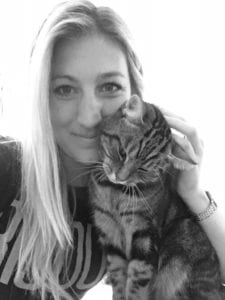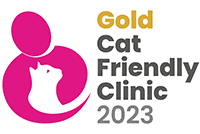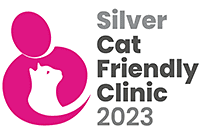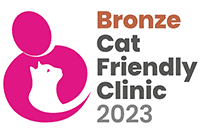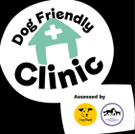Could you please introduce yourself and tell us a little about your career to date?
My name is Rosie, I grew up in Cambridge and then went to Vet School in Bristol. After graduating in 2013 I volunteered for the SPCA in Fiji (not as glamorous as its sounds!) before working in Suffolk. I first came to Village Vet Milton on work experience, when I was 14 years old and it was still Maple Cottage. I returned many times whilst I was a student to see practice and then in April 2016 they hired me! I am currently doing a certificate in Small Animal Medicine.
What challenges you the most about being a vet?
People’s perception of the cost of veterinary fees. Like my colleagues, I joined this career to look after and treat animals, and I swore an oath to do this. Inevitably, such care costs money. Unfortunately, due to the NHS (for which I am very grateful), most of the public have no idea how expensive medical care really is. As such, we are frequently accused of trying to make money when we only have the patient’s best interest at heart.
This was well reported in the Telegraph recently. “Last week, the Telegraph reported on a study which found that 85 percent of vets said they or a member of their team had felt threatened by clients who were angry at the cost of treatment. The cost of running a veterinary service is surprisingly high… If you look at a pie chart that shows how the money you give a vet is divided, you may be surprised at the breakdown. As an approximate guide: 20% of the money you hand over goes straight to the government as VAT; Around 20%goes to pay for veterinary nurses, receptionists and other support staff; Around 20% goes to pay for the cost of drugs and other stock items; Around 20% goes to pay for building, heating, lighting etc and round 20%is passed on to the vets, as their income. So, when people complain about high vets’ fees, which bit of the fees are they complaining about? Even if vets worked for nothing, this would still just amount to a 20% discount, which still leaves a sizeable sum of money to be paid!”
My point here is to ask clients to appreciate that our recommendations are based on the patient’s health and that alone. Also, please insure your pets!!
What excites you most about veterinary medicine?
Veterinary medicine is rapidly evolving and developing. Every year the veterinary world develop new drugs, new diagnostic tests and new surgical techniques. At the same time, research allows our understanding of diseases to evolve and improve. You really have to stay on the ball to keep up with the veterinary world, and this can only benefit our pets in the long run!
Why did you choose Village Vet?
I was keen to work in a hospital environment in order to work up the more challenging cases that I had previously had to refer. As a 24-hour hospital, we see many more emergency and critical care patients that are both challenging and rewarding, and I wanted this step up. Of course, it also helped that I knew multiple members of the team from my time as a student!
At your practice, what are some of the most common preventable ailments that you come across and can you provide us 3 top tips in relation to them for pet parents?
1) Cat flu
VACCINATE, VACCINATE, VACCINATE! Cat flu is much like flu in humans, it’s snotty, sweaty and makes you feel terrible, and the cats are no different! In addition, cats rely on their sense of smell to stimulate their appetite, not how food looks, so it is almost guaranteed to make a cat go off their food. It can also have long-lasting effects, such as eye ulcers and blindness, if not treated. The worst thing of all is that it is highly contagious. YET – it is easily preventable!! A course of two vaccinations three to four weeks apart in kittens, followed by yearly vaccinations will protect your cat from contracting flu. And it is not expensive either! Special offer vaccines with ourselves are only £25, which is a fraction of the cost of the treatment necessary if a cat was to contract flu.
It is worth noting that cats are also vaccinated against diseases we see more rarely but are fatal – feline leukaemia virus (FeLV) and panleucopeania – and these are included in the same vaccination course. Also, we DO NOT over vaccinate! Although your cat (or dog!) must visit the vets yearly for a vaccination, the content of the vaccination changes each year so that they receive the booster for each specific disease at appropriate time intervals. For example, the vaccination for FeLV lasts 3 years, whilst the vaccine for flu only lasts 1 year, so every year a cat will get a flu vaccine and every 3 they will get both! And the same applies to dogs!
2) Anxiety
Anxiety in dogs can result from a lack of appropriate socialisation as a puppy. One of the perks of my jobs is that I see lots of puppies for their initial vaccination courses. At this time, I always stress the importance of socialisation! Every puppy has a ‘socialisation window’ that starts when they are about 4 weeks old and ends when they are about 14 weeks old. During this time a puppy’s brain is open to making new associations and accepting new experiences. Therefore, it is essential to expose your puppy to as many experiences as possible, so that they learn that they are safe and “normal” and will not be scary in the future! This can start as soon as you take a puppy home – for example, they can meet other family members, the hoover, the post-man, music etc and then must continue as soon as they are safe to go out in the big bad world (one week after their second vaccination) when they can meet other dogs, traffic, shopping trolleys. Puppy classes can really help with this, and we can recommend these if requested.
3) “Brachycephalic Obstructive Airway Syndrome’ or BOAS
Pugs, French Bull Dogs, English Bull Dogs – cute, happy, friendly and most certainly trendy! However, how many people appreciate the health problems that are associated with these dogs having such a short (brachycephalic) nose?
Breeds with short noses have a squashed skeleton but normal amounts of skin and soft tissue, causing many problems:
- Their nostrils are small and compacted on their skull and consequently closed (“stenotic nares”).
- Their nasal cavities are short and twisted, making it difficult for air to flow through them.
- Their soft palate (the fleshy bit at the top of their mouth behind their hard palate) is too long and thick for their flat face, obstructing the back of their throat blocking their breathing.
- Their tongue, which would be of appropriate size for a long face, is too big for their shortened head and obstruct the mouth and throat further.
- Brachycephalic dogs compensate their malformations by “pulling” harder when they breathe in, which creates strong negative pressures in their throat, neck and chest, which in turn eventually cause secondary respiratory and digestive diseases. This is one of the reasons why brachycephalic dogs frequently regurgitate or vomit. Nearly all dogs suffering from airway obstruction secondary to BOAS also have stomach ulcers.
- Due to their breathing difficulties, these dogs are prone to heat stroke and collapse with normal levels of exercise or excitement, especially in warm weather.
- Excessive skin folds leave these dogs prone to skin disease and these folds may need to be surgically resected.
The answer to this is education! The public need to be aware of the suffering these dogs experience on a day to day basis. There is a strong drive from the veterinary community to remove these breeds from advertising and the media. We can only hope that the more people learn about these problems, the fewer people will want to buy them and the demand for breeding such compromised breeds will decrease.
What advice would you give to future veterinarians who are thinking about a career in veterinary medicine?
Being a vet is a vocation and a lifestyle choice, not just a job. If you want to go for cocktails after work, think again! Trust me, nine times out of ten you will not be fragrant enough to enter a bar and by the time you’ve finished work ‘happy hour’ has very much ended! It is rewarding and challenging, but it is long hours, hard work and not for the faint hearted.






